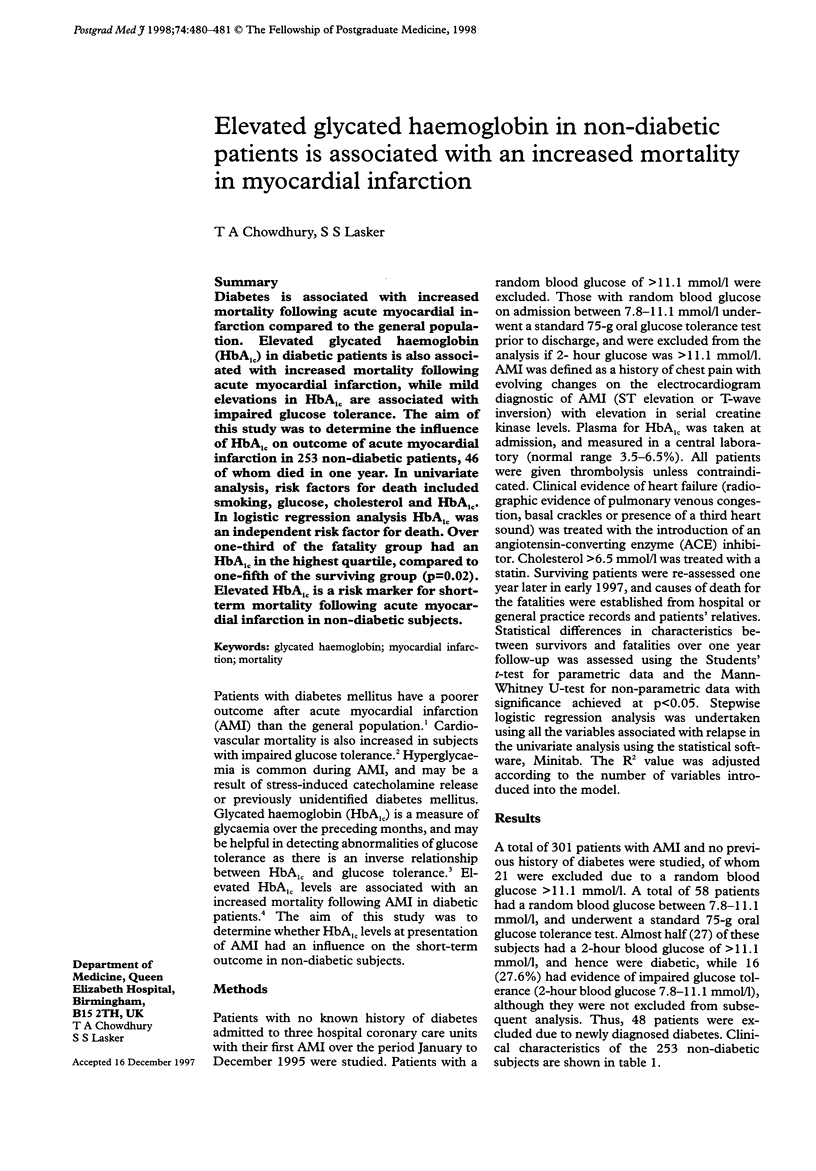Abstract
Diabetes is associated with increased mortality following acute myocardial infarction compared to the general population. Elevated glycated haemoglobin (HbA1c) in diabetic patients is also associated with increased mortality following acute myocardial infarction, while mild elevation in HbA1c are associated with impaired glucose tolerance. The aim of this study was to determine the influence of HbA1c on outcome of acute myocardial infarction in 253 non-diabetic patients, 46 of whom died in one year. In univariate analysis, risk factors for death included smoking, glucose, cholesterol and HbA1c. In logistic regression analysis HbA1c was an independent risk factor for death. Over one-third of the fatality group had an HbA1c in the highest quartile, compared to one-fifth of the surviving group (p = 0.02). Elevated HbA1c is a risk marker for short-term mortality following acute myocardial infarction in non-diabetic subjects.
Full text
PDF

Selected References
These references are in PubMed. This may not be the complete list of references from this article.
- Davies M., Rayman G., Day J. Increased incidence of coronary disease in people with impaired glucose tolerance: link with increased lipoprotein(a) concentrations? BMJ. 1992 Jun 20;304(6842):1610–1611. doi: 10.1136/bmj.304.6842.1610. [DOI] [PMC free article] [PubMed] [Google Scholar]
- Fuller J. H., Shipley M. J., Rose G., Jarrett R. J., Keen H. Coronary-heart-disease risk and impaired glucose tolerance. The Whitehall study. Lancet. 1980 Jun 28;1(8183):1373–1376. doi: 10.1016/s0140-6736(80)92651-3. [DOI] [PubMed] [Google Scholar]
- Gwilt D. J., Petri M., Lewis P. W., Nattrass M., Pentecost B. L. Myocardial infarct size and mortality in diabetic patients. Br Heart J. 1985 Nov;54(5):466–472. doi: 10.1136/hrt.54.5.466. [DOI] [PMC free article] [PubMed] [Google Scholar]
- Jaffe A. S., Spadaro J. J., Schechtman K., Roberts R., Geltman E. M., Sobel B. E. Increased congestive heart failure after myocardial infarction of modest extent in patients with diabetes mellitus. Am Heart J. 1984 Jul;108(1):31–37. doi: 10.1016/0002-8703(84)90541-6. [DOI] [PubMed] [Google Scholar]
- Lev-Ran A., VanderLaan W. P. Glycohemoglobins and glucose tolerance. JAMA. 1979 Mar 2;241(9):912–914. [PubMed] [Google Scholar]
- Sewdarsen M., Vythilingum S., Jialal I., Becker P. J. Prognostic importance of admission plasma glucose in diabetic and non-diabetic patients with acute myocardial infarction. Q J Med. 1989 May;71(265):461–466. [PubMed] [Google Scholar]
- Yudkin J. S., Oswald G. A., McKeigue P. M., Forrest R. D., Jackson C. A. The relationship of hospital admission and fatality from myocardial infarction to glycohaemoglobin levels. Diabetologia. 1988 Apr;31(4):201–205. doi: 10.1007/BF00290585. [DOI] [PubMed] [Google Scholar]


